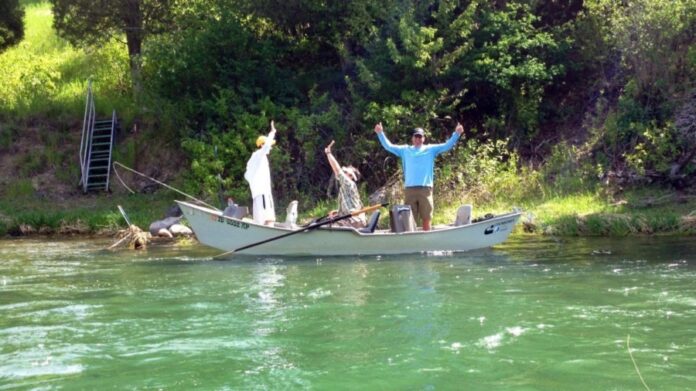Written By: Chris Jensen, The Lodge at Palisades Creek
Photo by TLAPC
Even after being a guide for 20 years, I still get a bit nervous before going on a guided float trip. I want to do everything right: catch fish, make a good impression, and most of all, not screw anything up. I’ve seen this same apprehension in my own clients as well, and while I do my best to be patient and understanding, it can be hard to calm the nerves of an inexperienced angler once they set in. So here are 5 tips for your next float trip that I hope will help you to be better-prepared and less anxious:
1. String up your Rod at the Boat Ramp
My clients often ask me what they can do to help when we get to the boat ramp. The best thing you can do is start getting your rod(s) strung up. By the time your guide has the boat ready, you’ll have your rods ready, and then your guide can skip right to adding tippet and flies, saving valuable time.

Photo by Evan Jones
2. Stay Inside the Knee Locks
Those funny looking “horns” in the front and back of the boat are designed to keep your legs locked in so you don’t fall out in the event the boat suddenly changes speed or direction. Standing in the knee locks also keeps the boat centered so that your guide can properly control it.
3. Face Forward
You should always be facing downstream. If you are in the front of the boat, your guide should not see your face until lunch, and if you’re in the back, you’ll be seeing the back of your guide’s head until lunch. This may sound a bit rigid, but losing focus on what’s ahead can lead to missed opportunities. There will be plenty of time to chat at lunch.

Photo by TLAPC
4. Respect Each Other’s Casting Zone
The angler in the front should be fishing as far ahead (downstream) of the boat as possible. If and when the boat catches up, and the fly drifts upstream of the oar, it’s time to re-cast. All the water upstream of the oars belongs to the angler in the back. Typically, the one in the back is also responsible for timing their casts so that they do not interfere with the front angler’s casts.
5. Embrace Teamwork
A good day on the water means that all 3 people in the boat are working together: the guide positions the boat, the angler up front gets the first shot at the prime water, while the angler in the back waits to cast until it’s clear. If one angler hooks a fish, the guide maneuvers the boat into the best position for landing the fish, and the other angler should be ready to reel in their line, and also to net the fish if the boat is in swift water. I’ve had days when there was a little too much competition between the anglers in my boat, which often leads to frustration and tangled lines. It’s more fun for everyone if you work as a team.
Chris Jensen is a former guide and current marketing liaison for The Lodge at Palisades Creek in Irwin, Idaho.
Credit: Source link






























